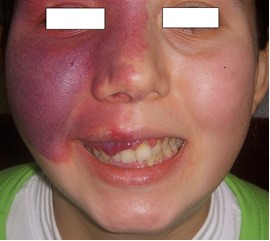(encephalotrigeminal angiomatosis, Sturge-Weber syndrome, Sturge-Weber-Dimitri)
Prevalence: 1/50.000. Sporadic phakomatosis due to a somatic mutation of the GNAQ gene (9q21).
Three main types:
- type I combining
1) a facial angioma ("port wine stain, birthmark") mainly in the ophthalmic territory of the trigeminal nerve (the upper eyelid and forehead are always included); it can be larger
2) a leptomeningeal angiomatosis involving the hemisphere ipsilateral to the facial angioma, sometimes with calcifications; epilepsy is frequent
3) a choroidal angiomatosis leading to glaucoma.
- type II is characterized by a cutaneous angioma without leptomeningeal angiomatosis,
- type III with only leptomeningeal angiomatosis without any cutaneous lesion (10 %)

Cases involving both sides have been reported. There is a low risk of pheochromocytoma.
To be noted: only about 10 % of the neonates with an angioma in the VIth nerve territory suffer from Sturge-Weber-Christian syndrome.
Anesthetic implications:
epilepsy. Glaucoma. Caution during intraoral manoeuvres in presence of angioma of the lips.
References :
- Batra RK, Gulaya V, Madan R, Trikha A.
Anaesthesia and the Sturge-Weber syndrome.
Can J Anesth 1994; 41: 133-6.
- Elajmi A, Clapuyt P, Hammer F, Bataille A-C, Lengele B, Boon LM.
Prise en charge des anomalies vasculaires chez l’enfant.
Ann Chir Plast Esth 2016 ; 61 :480-97
Updated: July 2022